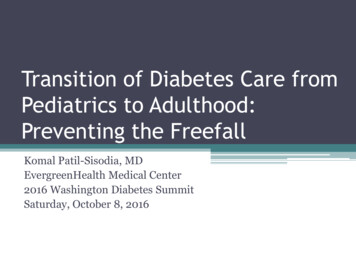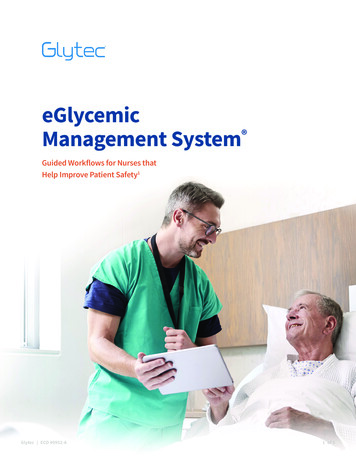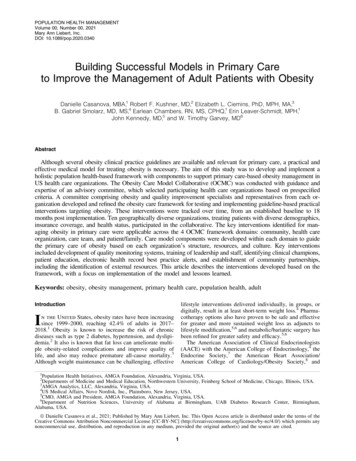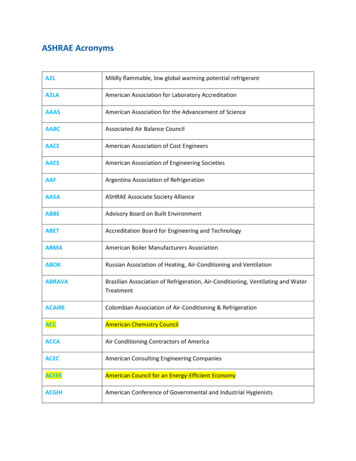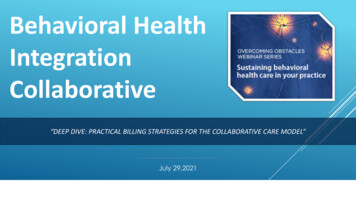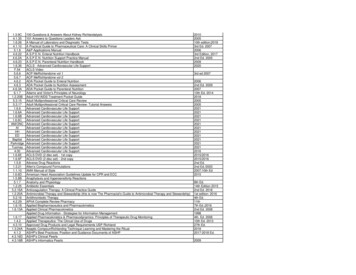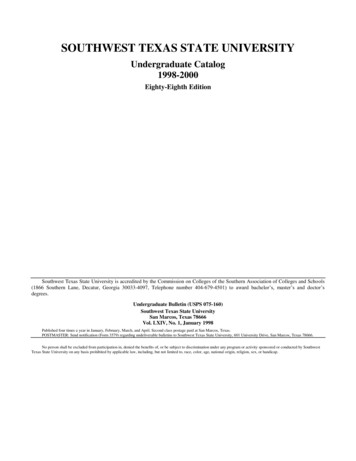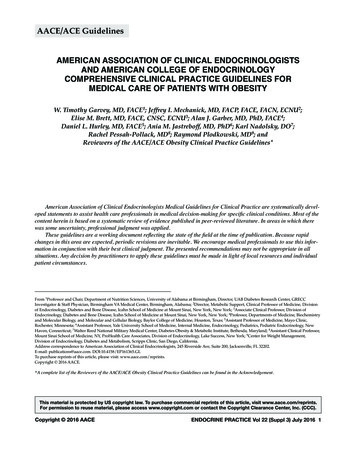
Transcription
AACE/ACE GuidelinesAMERICAN ASSOCIATION OF CLINICAL ENDOCRINOLOGISTSAND AMERICAN COLLEGE OF ENDOCRINOLOGYCOMPREHENSIVE CLINICAL PRACTICE GUIDELINES FORMEDICAL CARE OF PATIENTS WITH OBESITYW. Timothy Garvey, MD, FACE1; Jeffrey I. Mechanick, MD, FACP, FACE, FACN, ECNU2;Elise M. Brett, MD, FACE, CNSC, ECNU3; Alan J. Garber, MD, PhD, FACE4;Daniel L. Hurley, MD, FACE5; Ania M. Jastreboff, MD, PhD6; Karl Nadolsky, DO7;Rachel Pessah-Pollack, MD8; Raymond Plodkowski, MD9; andReviewers of the AACE/ACE Obesity Clinical Practice Guidelines*American Association of Clinical Endocrinologists Medical Guidelines for Clinical Practice are systematically developed statements to assist health care professionals in medical decision-making for specific clinical conditions. Most of thecontent herein is based on a systematic review of evidence published in peer-reviewed literature. In areas in which therewas some uncertainty, professional judgment was applied.These guidelines are a working document reflecting the state of the field at the time of publication. Because rapidchanges in this area are expected, periodic revisions are inevitable. We encourage medical professionals to use this information in conjunction with their best clinical judgment. The presented recommendations may not be appropriate in allsituations. Any decision by practitioners to apply these guidelines must be made in light of local resources and individualpatient circumstances.From 1Professor and Chair, Department of Nutrition Sciences, University of Alabama at Birmingham, Director, UAB Diabetes Research Center, GRECCInvestigator & Staff Physician, Birmingham VA Medical Center, Birmingham, Alabama; 2Director, Metabolic Support, Clinical Professor of Medicine, Divisionof Endocrinology, Diabetes and Bone Disease, Icahn School of Medicine at Mount Sinai, New York, New York; 3Associate Clinical Professor, Division ofEndocrinology, Diabetes and Bone Disease, Icahn School of Medicine at Mount Sinai, New York, New York; 4Professor, Departments of Medicine, Biochemistryand Molecular Biology, and Molecular and Cellular Biology, Baylor College of Medicine, Houston, Texas; 5Assistant Professor of Medicine, Mayo Clinic,Rochester, Minnesota; 6Assistant Professor, Yale University School of Medicine, Internal Medicine, Endocrinology, Pediatrics, Pediatric Endocrinology, NewHaven, Connecticut; 7Walter Reed National Military Medical Center, Diabetes Obesity & Metabolic Institute, Bethesda, Maryland; 8Assistant Clinical Professor,Mount Sinai School of Medicine, NY, ProHealth Care Associates, Division of Endocrinology, Lake Success, New York; 9Center for Weight Management,Division of Endocrinology, Diabetes and Metabolism, Scripps Clinic, San Diego, California.Address correspondence to American Association of Clinical Endocrinologists, 245 Riverside Ave, Suite 200, Jacksonville, FL 32202.E-mail: publications@aace.com. DOI:10.4158/EP161365.GLTo purchase reprints of this article, please visit: www.aace.com/reprints.Copyright 2016 AACE.*A complete list of the Reviewers of the AACE/ACE Obesity Clinical Practice Guidelines can be found in the Acknowledgement.ENDOCRINE PRACTICE Vol 22 (Suppl 3) July 2016 1
2 AACE/ACE Obesity CPG, Endocr Pract. 2016;22(Suppl 3)Introduction and Executive SummaryTable of Contents: AppendixEvidence BasePost-hoc Question: By inductive evaluation of all evidence-based recommendations, what are the corerecommendations for medical care of patients with obesity?Q1. Do the 3 phases of chronic disease prevention and treatment (i.e., primary, secondary, and tertiary) apply to thedisease of obesity?Q2. How should the degree of adiposity be measured in the clinical setting?Q2.1. What is the best way to optimally screen or aggressively case-find for overweight and obesity?4-3030303133Q2.2. What are the best anthropomorphic criteria for defining excess adiposity in the diagnosis of overweightand obesity in the clinical setting?34Q2.4. Do BMI and waist circumference accurately capture adiposity risk at all levels of BMI, ethnicity,gender, and age?34Q3.1. Diabetes risk, metabolic syndrome, and prediabetes (IFG, IGT)37Q2.3. Does waist circumference provide information in addition to body mass index (BMI) to indicateadiposity risk?Q3. What are the weight-related complications that are either caused or exacerbated by excess adiposity?Q3.2. Type 2 diabetesQ3.3. DyslipidemiaQ3.4. HypertensionQ3.5. Cardiovascular disease and cardiovascular disease mortalityQ3.6. Nonalcoholic fatty liver disease/nonalcoholic steatohepatitisQ3.7. Polycystic ovary syndrome (PCOS)Q3.8. Female infertilityQ3.9. Male hypogonadismQ3.10. Obstructive sleep apneaQ3.11. Asthma/reactive airway diseaseQ3.12. OsteoarthritisQ3.13. Urinary stress incontinenceQ3.14. Gastroesophageal reflux disease (GERD)Q3.15. DepressionQ4. Does BMI or other measures of adiposity convey full information regarding the impact of excess body weighton the patient’s health?3437394041424446474850505152525656Q5. Do patients with excess adiposity and related complications benefit more from weight loss than patientswithout complications, and, if so, how much weight loss would be required?58Q5.2. Is weight loss effective to treat to type 2 diabetes? How much weight loss would be required?60Q5.4. Is weight loss effective to treat hypertension? How much weight loss would be required?66Q5.1. Is weight loss effective to treat diabetes risk (i.e., prediabetes, metabolic syndrome) and preventprogression to type 2 diabetes? How much weight loss would be required?59Q5.3. Is weight loss effective to treat dyslipidemia? How much weight loss would be required?63Q5.5. Is weight loss effective to treat or prevent cardiovascular disease? How much weight loss would berequired?70Q5.5.1. Does weight loss prevent cardiovascular disease events or mortality?70Q5.5.3. Does weight loss improve congestive heart failure?71Q5.5.2. Does weight loss prevent cardiovascular disease events or mortality in diabetes?Q5.6. Is weight loss effective to treat nonalcoholic fatty liver disease and nonalcoholic steatohepatitis? Howmuch weight loss would be required?Q5.7. Is weight loss effective to treat PCOS? How much weight loss would be required?Q5.8. Is weight loss effective to treat infertility in women? How much weight loss would be required?70727476
AACE/ACE Obesity CPG, Endocr Pract. 2016;22(Suppl 3) 3Q5.9. Is weight loss effective to treat male hypogonadism? How much weight loss would be required?78Q5.11. Is weight loss effective to treat asthma/reactive airway disease? How much weight loss would berequired?80Q5.10. Is weight loss effective to treat obstructive sleep apnea? How much weight loss would be required?80Q5.12. Is weight loss effective to treat osteoarthritis? How much weight loss would be required?81Q5.14. Is weight loss effective to treat gastroesophageal reflux disease (GERD)? How much weight loss wouldbe required?83Q5.13. Is weight loss effective to treat urinary stress incontinence? How much weight loss would be required?82Q5.15. Is weight loss effective to improve symptoms of depression? How much weight loss would berequired?89Q6.1. Meal plan and macronutrient composition92Q6. Is lifestyle/behavioral therapy effective to treat overweight and obesity, and what components of lifestyletherapy are associated with efficacy?Q6.2. Physical activityQ6.3. Behavior interventionsQ7. Is pharmacotherapy effective to treat overweight and obesity?Q7.1. Should pharmacotherapy be used as an adjunct to lifestyle therapy?Q7.2. Does the addition of pharmacotherapy produce greater weight loss and weight-loss maintenance thanlifestyle therapy alone?919396102102102Q7.3. Should pharmacotherapy only be used in the short term to help achieve weight loss or should it be usedchronically in the treatment of obesity?103Q7.5. Should combinations of weight-loss medications be used in a manner that is not approved by the U.S.Food and Drug Administration?108Q7.4. Are there differences in weight-loss drug efficacy and safety?Q8. Are there hierarchies of drug preferences in patients with the following disorders or characteristics?Q8.1. Chronic kidney diseaseQ8.2. NephrolithiasisQ8.3. Hepatic impairmentQ8.4. Hypertension104108108109110111Q8.5. Cardiovascular disease and arrhythmia113Q8.7. Anxiety118Q8.6. Depression with or without selective serotonin reuptake inhibitorsQ8.8. Psychotic disorders with or without medications (lithium, atypical antipsychotics, monoamine oxidaseinhibitors)115119Q8.9. Eating disorders including binge eating disorder121Q8.11. Seizure disorder124Q8.10. GlaucomaQ8.12. PancreatitisQ8.13. Opioid useQ8.14. Women of reproductive potentialQ8.15. The elderly, age 65 yearsQ8.16. Addiction/alcoholismQ8.17. Post-bariatric surgeryQ9. Is bariatric surgery effective to treat obesity?Q9.1. Is bariatric surgery effective to treat obesity and weight-related complications?Q9.2. When should bariatric surgery be used to treat obesity and weight-related 30131131132132134192-203
4 AACE/ACE Obesity CPG, Endocr Pract. 2016;22(Suppl 3)ABSTRACTObjective: Development of these guidelines ismandated by the American Association of ClinicalEndocrinologists (AACE) Board of Directors and theAmerican College of Endocrinology (ACE) Board ofTrustees and adheres to published AACE protocols forthe standardized production of clinical practice guidelines(CPGs).Methods: Recommendations are based on diligentreview of clinical evidence with transparent incorporationof subjective factors.Results: There are 9 broad clinical questions with 123recommendation numbers that include 160 specific statements (85 [53.1%] strong [Grade A]; 48 [30.0%] intermediate [Grade B], and 11 [6.9%] weak [Grade C], with 16[10.0%] based on expert opinion [Grade D]) that build acomprehensive medical care plan for obesity. There were133 (83.1%) statements based on strong (best evidencelevel [BEL] 1 79 [49.4%]) or intermediate (BEL 2 54[33.7%]) levels of scientific substantiation. There were 34(23.6%) evidence-based recommendation grades (GradesA-C 144) that were adjusted based on subjective factors.Among the 1,790 reference citations used in this CPG, 524(29.3%) were based on strong (evidence level [EL] 1),605 (33.8%) were based on intermediate (EL 2), and 308(17.2%) were based on weak (EL 3) scientific studies, with353 (19.7%) based on reviews and opinions (EL 4).Conclusion: The final recommendations recognizethat obesity is a complex, adiposity-based chronic disease,where management targets both weight-related complications and adiposity to improve overall health and qualityof life. The detailed evidence-based recommendationsallow for nuanced clinical decision-making that addressesreal-world medical care of patients with obesity, including screening, diagnosis, evaluation, selection of therapy,treatment goals, and individualization of care. The goal isto facilitate high-quality care of patients with obesity andprovide a rational, scientific approach to management thatoptimizes health outcomes and safety. (Endocr Pract.2016;22:Supp3;1-205)Abbreviations:A1C hemoglobin A1c; AACE American Associationof Clinical Endocrinologists; ACE American Collegeof Endocrinology; ACSM American College of SportsMedicine; ADA American Diabetes Association;ADAPT Arthritis, Diet, and Activity Promotion Trial;ADHD attention-deficit hyperactivity disorder; AHA American Heart Association; AHEAD Action forHealth in Diabetes; AHI apnea-hypopnea index; ALT alanine aminotransferase; AMA American MedicalAssociation; ARB angiotensin receptor blocker; ART assisted reproductive technology; AUC area underthe curve; BDI Beck Depression Inventory; BED binge eating disorder; BEL best evidence level;BLOOM Behavioral Modification and Lorcaserin forOverweight and Obesity Management; BLOSSOM Behavioral Modification and Lorcaserin Second Studyfor Obesity Management; BMI body mass index;BP blood pressure; C-SSRS Columbia SuicidalitySeverity Rating Scale; CAD coronary artery disease;CARDIA Coronary Artery Risk Development inYoung Adults; CBT cognitive behavioral therapy;CCO Consensus Conference on Obesity; CHF congestive heart failure; CHO carbohydrate; CI confidence interval; COR-I Contrave ObesityResearch I; CPG clinical practice guideline; CV cardiovascular; CVD cardiovascular disease; DASH Dietary Approaches to Stop Hypertension; DBP diastolic blood pressure; DEXA dual-energy X-rayabsorptiometry; DPP Diabetes Prevention Program;DSE diabetes support and education; EL evidence level; ED erectile dysfunction; ER extendedrelease; EWL excess weight loss; FDA Food andDrug Administration; FDG 18F-fluorodeoxyglucose;GABA gamma-aminobutyric acid; GERD gastroesophageal reflux disease; GI gastrointestinal; GLP-1 glucagon-like peptide 1; HADS Hospital Anxietyand Depression Scale; HDL-c high-density lipoprotein cholesterol; HR hazard ratio; HTN hypertension; HUNT Nord-Trøndelag Health Study; ICSI intracytoplasmic sperm injection; IFG impaired fasting glucose; IGT impaired glucose tolerance; ILI intensive lifestyle intervention; IVF in vitro fertilization; LAGB laparoscopic adjustable gastric banding;LDL-c low-density lipoprotein cholesterol; LES lower esophageal sphincter; LSG laparoscopic sleevegastrectomy; LV left ventricle; LVH left ventricular hypertrophy; LVBG laparoscopic vertical bandedgastroplasty; MACE major adverse cardiovascularevents; MAOI monoamine oxidase inhibitor; MI myocardial infarction; MNRCT meta-analysis ofnon-randomized prospective or case-controlled trials;MRI magnetic resonance imaging; MUFA monounsaturated fatty acid; NAFLD nonalcoholic fatty liverdisease; NASH nonalcoholic steatohepatitis; NES night eating syndrome; NHANES National Healthand Nutrition Examination Surveys; NHLBI NationalHeart, Lung, and Blood Institute; NHS Nurses’ HealthStudy; NICE National Institute for Health and CareExcellence; OA osteoarthritis; OGTT oral glucosetolerance test; OR odds ratio; OSA obstructivesleep apnea; PHQ-9 Patient Health Questionnaire;PCOS polycystic ovary syndrome; PCP primary care physician; POMC pro-opiomelanocortin;POWER Practice-Based Opportunities for WeightReduction; PPI proton pump inhibitor; PRIDE Program to Reduce Incontinence by Diet and Exercise;
AACE/ACE Obesity CPG, Endocr Pract. 2016;22(Suppl 3) 5PSA prostate specific antigen; QOL quality of life;RA receptor agonist; RCT randomized controlledtrial; ROC receiver operator characteristic; RR relative risk; RYGB Roux-en-Y gastric bypass; SAD sagittal abdominal diameter; SBP systolic blood pressure; SCOUT Sibutramine Cardiovascular OutcomeTrial; SG sleeve gastrectomy; SHBG sex hormonebinding globulin; SIEDY Structured Interview onErectile Dysfunction; SNRI serotonin-norepinephrinereuptake inhibitors; SOS Swedish Obese Subjects;SS surveillance study; SSRI selective serotoninreuptake inhibitors; STORM Sibutramine Trial onObesity Reduction and Maintenance; TCA tricyclicantidepressant; TONE Trial of NonpharmacologicIntervention in the Elderly; TOS The Obesity Society;T2DM type 2 diabetes mellitus; UKPDS UnitedKingdom Prospective Diabetes Study; U.S. UnitedStates; VAT visceral adipose tissue; VLDL verylow-density lipoprotein; WC waist circumference;WHO World Health Organization; WHR waist-hipratio; WHtR waist-to-height ratio; WMD weightedmean difference; WOMAC Western Ontario andMcMaster Universities osteoarthritis index; XENDOS XEnical in the Prevention of Diabetes in ObeseSubjects“Corpulence is not only a disease itself, but theharbinger of others.” HippocratesI. INTRODUCTION AND RATIONALEObesity rates have increased sharply over the past30 years, creating a global public health crisis (1 [EL 3;SS]; 2 [EL 2; MNRCT]; 3 [EL 3; CSS]). Global estimatessuggest that 500 million adults have obesity worldwide (2[EL 2; MNRCT]) with prevalence rates increasing amongchildren and adolescents (3 [EL 3; CSS]; 4 [EL 3; SS]; 5[EL 3; SS]). Data from the National Health and NutritionExamination Surveys show that roughly 2 of 3 UnitedStates (U.S.) adults have overweight or obesity, and 1 of3 adults has obesity (1 [EL 3; SS]; 2 [EL 2; MNRCT]; 3[EL 3; CSS]). The impact of obesity on morbidity, mortality, and health care costs is profound. Obesity and weightrelated complications exert a huge burden on patient suffering and social costs (6 [EL 3; SS]; 7 [EL 3; SS]). Obesityis estimated to add 3,559 annually (adjusted to 2012 dollars) to per-patient medical expenditures as compared topatients who do not have obesity; this includes 1,372 eachyear for inpatient services, 1,057 for outpatient services,and 1,130 for prescription drugs (6 [EL 3; SS]).In recent years, exciting advances have occurred in all3 modalities used to treat obesity: lifestyle intervention,pharmacotherapy, and weight-loss procedures, includingbariatric surgery (8 [EL 4; NE]). Clinical trials have established the efficacy of lifestyle and behavioral interventionsin obesity; moreover, there are 5 weight-loss medicationsapproved by the U.S. Food and Drug Administration (FDA)for chronic management of obesity (9 [EL 4; NE]; 10 [EL 4;NE]). Bariatric surgical practices have been developed andrefined, together with improvements in pre- and postoperative care standards, resulting in better patient outcomes (11[EL 4; NE]). The FDA has also recently approved devicesinvolving electrical stimulation and gastric balloons forthe treatment of obesity. In addition to enhanced treatmentoptions, the scientific understanding of the pathophysiology of obesity has advanced, and it is now viewed as acomplex chronic disease with interacting genetic, environmental, and behavioral determinants that result in seriouscomplications (10 [EL 4; NE]). Adipose tissue itself is anendocrine organ which can become dysfunctional in obesity and contribute to systemic metabolic disease. Weightloss can be used to prevent and treat metabolic disease concomitant with an improvement in adipose tissue functionality. These new therapeutic tools and scientific advancesnecessitate development of rational medical care modelsand robust evidenced-based therapeutic approaches, withthe intended goal of improving patient well-being and recognizing patients as individuals with unique phenotypes inunique settings.In 2012, the American Association of ClinicalEndocrinologists (AACE) published a position statementdesignating obesity as a disease and providing the rationalefor this designation (12 [EL 4; NE]). Subsequently, AACEwas joined by multiple professional organizations in submitting a resolution to the American Medical Association(AMA) to recognize obesity as a disease. In June 2013, following a vote by its House of Delegates, the AMA adopteda policy designating obesity as a chronic disease (13 [EL 4,NE]). These developments have the potential to acceleratescientific study of the multidimensional pathophysiologyof obesity and present an impetus to our health care systemto provide effective treatment and prevention.In May of 2014, AACE and the American Collegeof Endocrinology (ACE) sponsored their first ConsensusConference on Obesity (CCO) in Washington, DC, toestablish an evidence base that could be used to developa comprehensive plan to combat obesity (14 [EL 4; NE]).The conference convened a wide array of national stakeholders (the “pillars”) with a vested interest in obesity. Theconcerted participation of these stakeholders was recognized as necessary to support an effective overall actionplan, and they included health professional organizations,government regulatory agencies, employers, health careinsurers, pharmaceutical industry representatives, researchorganizations, disease advocacy organizations, and healthprofession educators.A key consensus concept that emerged from the CCOwas that a more medically meaningful and actionable
6 AACE/ACE Obesity CPG, Endocr Pract. 2016;22(Suppl 3)definition of obesity was needed. It became clear that diagnosis based solely on body mass index (BMI) lacked theinformation needed for effective interaction and concertedpolicy regarding obesity among stakeholders (14 [EL 4;NE]) and was a barrier to the development of acceptableand rational approaches to medical care. It was agreed thatthe elements for an improved obesity diagnostic processshould include BMI alongside an indication of the degreeto which excess adiposity negatively affects an individualpatient’s health.In response to this emergent concept from the CCO,the AACE proposed an “Advanced Framework for a NewDiagnosis of Obesity.” This document features an anthropometric component that is the measure of adiposity (i.e.,BMI) and a clinical component that describes the presenceand severity of weight-related complications (15 [EL 4;NE]). Given the multiple meanings and perspectives associated with the term “obesity” in our society, there wasalso discussion that the medical diagnostic term for obesityshould be “adiposity-based chronic disease” (ABCD).The paradigm for obesity care proposed by theNational Heart, Lung, and Blood Institute (16 [EL 4; NE]),and FDA-sanctioned prescribing information for the use ofobesity medications (17 [EL 4; NE]), largely bases indications for therapeutic modalities on patient BMI (a BMIcentric approach). As part of the AACE Clinical PracticeGuidelines (CPG) for Developing a Diabetes MellitusComprehensive Care Plan (18 [EL 4; NE]), an algorithmfor obesity management was proposed wherein the presence and severity of weight-related complications constitute the primary determinants for treatment modality selection and weight-loss therapy intensity (19 [EL 4; NE]).In this new complications-centric approach, the primarytherapeutic endpoint is improvement in adiposity-relatedcomplications, not a preset decline in body weight (8 [EL4; NE]). Thus, the main endpoint of therapy is to measurably improve patient health and quality of life. Otherorganizations such as the American Heart Association, theAmerican College of Cardiology, The Obesity Society (20[EL 4; NE]), the Obesity Medical Association (21 [EL 4;NE]), and the Endocrine Society (22 [EL 4; NE]) have alsodeveloped obesity care guidelines and algorithms incorporating aspects of a complications-centric approach.This AACE/ACE evidence-based clinical practiceguideline (CPG) is structured around a series of a priori, relevant, intuitive, and pragmatic questions that address keyand germane aspects of obesity care: screening, diagnosis,clinical evaluation, treatment options, therapy selection,and treatment goals. In aggregate, these questions evaluate obesity as a chronic disease and consequently outlinea comprehensive care plan to assist the clinician in caringfor patients with obesity. This approach may differ fromother CPGs. Specifically, in other CPGs: the scientific evidence is first examined and then questions are formulatedonly when strong scientific evidence exists (e.g., randomized controlled trials [RCTs]), and/or only certain aspectsof management (e.g., pharmacotherapy) are chosen for afocused (but not comprehensive) CPG.Neither of these approaches addresses the totality, multiplicity, or complexity of issues required to provide effective, comprehensive obesity management applicable toreal-world patient care. Moreover, the nuances of obesitycare in an obesogenic-built environment, which at timeshave an overwhelming socioeconomic contextualization, require diligent analysis of the full weight of extantevidence.To this end, these CPGs address multiple aspects ofpatient care relevant to any individual patient encounter,assess the available evidence base, and provide specificrecommendations. The strength of each recommendationis commensurate with the strength-of-evidence. In thisway, these CPGs marshal the best existing evidence toaddress the key questions and decisions facing cliniciansin the real-world practical care of patients with obesity.This methodology is transparent and outlined in multiple AACE/ACE processes for producing guideline protocols (23 [EL 4; NE]; 24 [EL 4; NE]; 25 [EL 4; NE]).Implementing these CPGs should facilitate high-qualitycare of patients with obesity and provide a rational, scientific approach to management that optimizes outcomes andsafety. Thus, these CPGs will be useful for all health careprofessionals involved in the care of patients with, or atrisk for, obesity and adiposity-related complications.II. MANDATEIn 2015, the AACE Executive Committee and theAACE Board of Directors mandated the development ofCPGs for obesity to provide a set of evidence-based recommendations for the comprehensive care of patients withoverweight or obesity, including an end goal of optimizingpatient outcomes. The selection of the chair, primary writers, and reviewers was made by the President of the AACE,in consultation with the AACE Executive Committee.The charge was to develop evidence-based CPGs in strictadherence with the process established in the 2004 AACEProtocol for Standardized Production of Clinical PracticeGuidelines (23 [EL 4; NE]) and the 2010 and 2014 updates(24 [EL 4; NE]; 25 [EL 4; NE]). The development of theseobesity CPGs complements other AACE/ACE activities inobesity medicine, namely the new complications-centricframework for the diagnosis and management of overweight and obesity (15 [EL 4; NE]), bariatric surgery CPGs(11 [EL 4; NE]), healthy eating CPGs (26 [EL 4; NE]),diabetes comprehensive care CPGs (18 [EL 4; NE]; 19 [EL4; NE]), obesity and nutrition position statements (12 [EL4; NE]), and other educational programs and white papers(14 [EL 4; NE]).
AACE/ACE Obesity CPG, Endocr Pract. 2016;22(Suppl 3) 7III. METHODSThis AACE/ACE CPG on Obesity is developedaccording to established AACE/ACE methodology forguidelines development (23 [EL 4; NE]; 24 [EL 4; NE]; 25[EL 4; NE]) and is characterized by the following salientattributes:1. Appointment of credentialed experts who have disclosed all multiplicities of interests, vetted by theAACE Publications Committee;2. Incorporation of middle-range literature searching with: (1) an emphasis on strong evidence andthe identification of all relevant RCTs and metaanalyses; (2) inclusion of relevant cohort studies,nested case-control studies, and case series; and (3)inclusion of more general reviews/opinions, mechanistic studies, and illustrative case reports whenconsidered appropriate;3. An orientation on questions that are directly relevant to patient care;4. Use of a technical a priori methodology, whichmaps strength-of-evidence to recommendationgrades and stipulates subjective factors establishedin the AACE/ACE Protocol for StandardizedProduction of Clinical Practice Guidelines (23 [EL4; NE]; 24 [EL 4; NE]; 25 [EL 4; NE]); and5. Employment of a multilevel review process andhigh level of diligence.Task Force AssignmentsThe logistics and process for task force assignmentsadhered to the AACE Protocol for Standardized Productionof Clinical Practice Guidelines (23 [EL 4; NE]; 24 [EL4; NE]; 25 [EL 4; NE]). The selection of the chair, primary writing team, and reviewers was based on the expertcredentials of these individuals in obesity medicine. Allappointees are AACE members and are experts in obesitycare. All multiplicities of interests for each individual participant are clearly disclosed and delineated in this document. No appointee is employed by industry, and there wasno involvement of industry in the development of theseCPGs.Question/Problem Structurefor Guidelines DevelopmentThe goal was to develop CPGs that are comprehensiveand relevant to clinicians. Therefore, the questions for evidence-based review reflect the multiple aspects of management that must be addressed by clinicians as they evaluate, screen, and diagnose patients with obesity; establisha clinical database; make treatment decisions; and assesstherapeutic outcomes. The primary writing team draftedquestions for evidence-based review and, following multiple and interactive discussions, arrived at a consensus forthe final question list addressed in these CPGs.Evidence-Based ReviewOnce the questions were finalized, the next step was toconduct a systematic electronic search of the literature pertinent to each question. The task force chair assigned eachquestion to a member of the task force writing team, andthe team members executed a systematic electronic searchof the published literature from relevant bibliographic databases for each clinical question. The objective was to identify all publications necessary to assign the true strengthof-evidence, given the totality of evidence available inthe literature. The mandate was to include all studies thatmaterially impact the strength of the evidence level. Thus,all RCTs and meta-analyses were to be identified (whetherthey provided positive or negative data with respect toeach question) because these studies would predominate inscoring the strength-of-evidence. The writing team members also identified relevant nonrandomized interventions,cohort studies, and case-control trials, as well as crosssectional studies, surveillance studies, epidemiologic data,case series, and pertinent studies of disease mechanisms. Inthe absence of RCTs, recommendations would necessarilyrely on lower levels of evidence, which would in turn affectthe strength of the ensuing recommendations.For the systematic review of all clinical trials andmeta-analyses, each task force member conducted a searchof the Cochrane Library (which includes all references inthe Cochrane Central Register of Controlled Trials) (27 [EL4; NE]). A search was conducted without date limits for alltrials, using “obesity” and/or “weight loss” as key searchterms together with term(s) relevant to the question beingaddressed. In addition, all relevant trials and meta-analyseswere identified in a search of the PubMed database.
Endocrinologists (AACE) Board of Directors and the American College of Endocrinology (ACE) Board of Trustees and adheres to published AACE protocols for the standardized production of clinical practice guidelines (CPGs). Methods: Recommendations are based on diligent review of clinical evidence with transparent incorporation of subjective factors.
